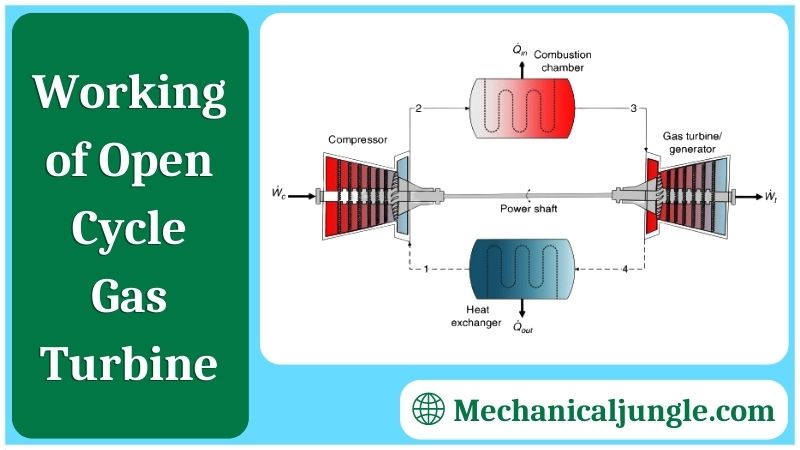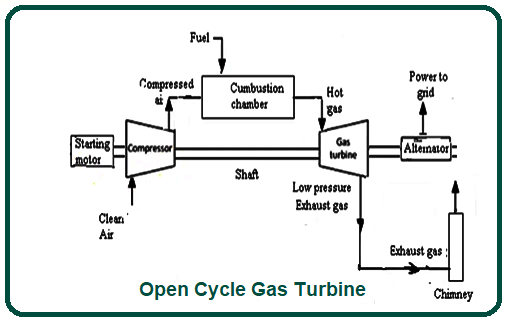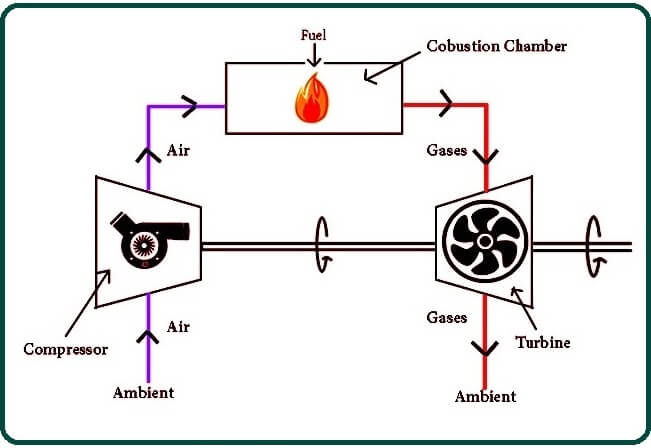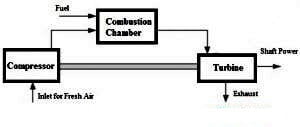Important Point
What Is the Open Cycle Gas Turbine?
Open-cycle gas turbines can be defined as the turbine plant that is fired using liquid fuel to rotate the generator to produce electricity. Residual heat can be worn into the environment at 550o Celsius. The generator and turbine are attached to reduce noise levels and occupy an approximate area such as 75 m X 25 m for each unit. The height of the exhaust stacks can be approximately 30 meters through the intake structure at 20 m height.
The major components used in open cycle gas turbines include a compressor, combustion chamber, turbine, control, and start-up. A compressor uses air from the environment and lowers it to several stages within the compressor. Liquid fuel can be supplied to combustion chambers, where the chamber contains compressed air. After that, the mixture of both air & fuel can be ignited to produce gas with high velocity.
This gas can be supplied by using the blades of the turbine blades to turn the shaft which is connected to the rotor within the generator. Rotations of the rotor can be done within a stator to generate electricity. After that, this power can be supplied through a network of high voltage wherever required.
Gas turbines can be classified based on three main phenomena such as the process of combustion, the working of the material path, and the action of the combustion gases within the turbine.
Working of Open Cycle Gas Turbine:
#1. Isentropic Compression
From 1 to 2, air enters the compressor. After entering the compressors, the air is compressed by the compressors. As the air is compressed by the compressors, its volumes decrease from V1 to V2, and the pressure increases from P1 to P2.
It is assumed that the entropy remains constants, no heat is transferred during this process, but the temperature will increase due to compressions from T1 to T2.
#2. Isobaric Expansion
From 2 to 3, the compressed air from the compressor will enter the burner. In the burner, the temperature will increase, & the volume will also increase from V2 to V3 due to expansion due to heating.
This process will be a continuous pressure process. The fuel will enter the chamber from above and mix with the air before burning. After burning, the temperature will rise and expand.
In the P – V diagram, the pressure (P) will remain constant, & the volume will increase from V2 to V3. In the T-S diagram, the temperatures (T) will increase from T2 to T3, and the entropy from S2 to S3 will also increase.
#3. Isentropic Expansion
From 3 to 4, the hot air from the burner or combustion chamber will reach the turbine, and the air inside the turbine will expand, and some work will be done due to the expansion. This process will be an isentropic process, & no heat will be transferred during this process. In this process, the volume will increase due to expansion, and the pressure will decrease. This process will be the opposite of the 1 to 2 process.
In the P-V diagram, the volume (V) will increase from V3 to V4, and the pressure (P) will decrease from P3 to P4. In the T-S diagram, the temperature (T) will decrease from T3 to T4, and the entropy (S) will remain constant.
#4. Gas Released into the Atmosphere
From 3 to 4, the air from the turbine will be released into the atmosphere. Also, air will be drawn from the atmosphere to the compressor, and the whole cycle will repeat again.
In the P – V diagram, the pressure (P) will remain constant, and the volume (V) will decrease from V3 to V4.
In the T-S diagram, temperature (T) will decrease from T3 to T4, and Entropy (S) will also decrease from S3 to S4.
Components of Open Cycle Gas Turbine:
#1. Compressor
The compressor is used to compress the air. Most common axial flow compressors are used in an open cycle gas turbine.
#2. Burner or Combustion Chamber
After passing through the compressor, air enters the burner or A. Combustion chamber. In this burner, a constant pressure process will occur. The pressure will be constant, but the temperature will rise.
#3. Turbine
The isentropic process will also be done in the turbine. When the hot gas from the combustion chamber reaches the turbine, it will expand into the turbine. As the gas expands, some work will be done by the gas, and then it will escape from the system.
Also, Read: Construction of Dog Clutch | Working of Dog Clutch | Advantages of Dog Clutch | Disadvantages of Dog Clutch
Working Principle of Open Cycle Gas Turbine:
The open cycle gas turbine diagrams are shown below. The working principle of OCGT is when fresh air enters the compressor at ambient temperature, where the temperature rises both as well as the temperature. High-force air can enter the combustion chamber, where liquid fuel can move at a constant force. High-temperature gas can enter the turbine, where it increases the ambient force and generates electricity.
The main features of an open-cycle gas turbine include the following.
- It is applicable for combined cycles.
- Open cycle gas turbine efficiencies are high thermal up to 44%.
- Long life and reliability are high.
- It is also used in electric power as well as in the propulsion of aircraft.
- The start-up time for the turbine is as fast as 2 minutes compared to the steam-propulsion system because it takes four hours.
- The back work ratio is up to 50% higher than the low percentage within the steam power plant.
Also, Read: Parts of Benson Boiler | Working Principle of Benson Boiler | Construction of Benson Boiler
Advantages of Open Cycle Gas Turbine:
The benefits of open-cycle gas turbines include the following.
- This gas turbine is not working, so it depends on the pressure of the atmosphere, so any type of force can be used to improve specific plant production. Once the pressure is applied to the turbines, the size of the components used in them can be reduced.
- The gas used in these turbines can be of any type. For example, the combination of helium and helium and carbon dioxide can give high efficiency, so it is used in nuclear plants.
- Simplicity, low weight, and cost
- Turbine blades are not contaminated through combustion products.
- Turbine regulation is very simple.
- Low thermal stresses may exist at different loads due to constant temperature.
Disadvantages of Open Cycle Gas Turbine:
Disadvantages of open-cycle gas turbines include the following.
- An exchanger with fast heat is required whenever high forces are applied to the input of the compressor.
- The results of poor heat transfer and poor combustion efficiency are mainly due to the heat exchanger based on the indirect type.
- In this type of turbine, the combustion chamber is more efficient and is applicable to a larger volume of air.
- They are sensitive.
- The part-load efficiency of these turbines is poor.
Also, Read: What Is Taper Turning? | Taper Turning and Its Types | Different Types of Taper Turning Methods
Applications of Open Cycle Gas Turbine:
Applications of the open-cycle gas turbines include the following.
- Generally, gas turbines are used to provide aviation power, especially for jet propulsion.
- Electric power generation.
- Some industrial processes.
- Industries.
- Propulsion of marine, automotive, and locomotives.
- They are used in the application of mechanical drives.
Frequently Asked Questions (FAQ)
What Is Open Cycle Gas Turbine?
Open-cycle gas turbine. Definition English: A gas turbine prime mover in which air is compressed in the compressor element, fuel is injected and burned in the combustor, and the hot products are expanded in the turbine element and exhausted into the atmosphere.
Working of Open Cycle Gas Turbine
An open cycle gas turbine works by drawing in fresh atmospheric air and compressing it using either centrifugal or axial flow compressors. The compressor takes the atmospheric air and compresses it through a series of compressor stages. Compressed air is mixed with fuel once it is injected into the combustion chamber.
Open Cycle Gas Turbine Works On
The open cycle gas turbine operates on the principle of drawing the fresh atmospheric air at ambient conditions into the compressor, where the air is compressed by a centrifugal or an axial flow compressor.
Components of Open Cycle Gas Turbine
Gas turbines are composed of three main components: compressor, combustor, and power turbine. In the compressor section, the air is drawn in and compressed up to 30 times ambient pressure and directed to the combustor section, where fuel is introduced, ignited, and burned.
Advantages of Open Cycle Gas Turbine
- It occupies less floor space.
- Maintenance cost is low.
- Low capital cost.
- Less weight and smaller size.
- It requires no cooling water.
- Warm-up time is considerably less.
Like this post? Share it with your friends!
Suggested Read –
- Normalizing Process
- Scotch Marine Boilers
- What Is Normalizing Process? | Normalizing Process Procedure | Purpose of Normalizing Process
- Watt Governor | Construction of Watt Governor | Working of Watt Governor | Limitations of Watt Governor
- Scotch Yoke Mechanism | Working Principle of Scotch Yoke Mechanism | Construction of Scotch Yoke Mechanism
- Working of Locomotive Boiler | Parts of Locomotive Boiler | Advantages of Locomotive Boiler | Disadvantages of Locomotive Boiler
- Turbine Function | Turbine Function of Thermal Power Plant | What Is Steam Turbine Function | Working Principle of Steam Turbine Function





Leave a Reply